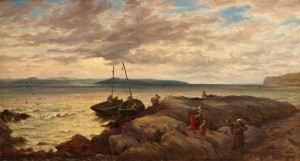LANDING FISH AT BLACKROCK (17-05-12)

Our image today is of a painting entitled “Morning – Landing Fish at Blackrock, Galway Bay” by an English painter named Thomas Rose Miles dated c. 1895. There is probably a little artistic licence taken but it is a fascinating study of the bay which is very difficult to capture in paint. There is just a thin strip of land visible on the far side, nothing very dramatic, and of course the light and colours change constantly. The sunlit area we see on the Clare coast corresponds to Ballyvaughan and the landmass to the west of that has been darkened for artistic effect. Though they are probably not visible in this reproduction, there are a lot of fishing boats on the bay.
The main focus of interest for us is the foreground, Black Rock. There was a great tradition of fishing from this area. There was a cluster of thatched fishermen’s cottages at Blackrock until the Night of the Big Wind when they were literally blown away by the storm and the tide, and the occupants had to move further inland. This painting shows two boats moored at the rock and being unloaded of their catch which is being carried ashore in creels by barefoot women wearing red petticoats and small wraparound shawls.
In 1885, Salthill was expanding . It was a warm summer and there were many visitors. Blackrock was a favourite place for men bathing and Mr. Moon and some of his friends placed a springboard there. However, this did not go down very well with the landowner, Colonel O’Hara and he made it very difficult for the bathers to get to the rock at all. He had the board removed which inspired a local bard to write a few verses which began, “O James asthore, we all feel sore / after getting such a shock / when the colonel roared / take off that board / from my fine big black rock”. O’Hara took six of the bathers to court, and this resulted in a public meeting which was held in the Town Hall. It was declared that people had been bathing at the rock since time immemorial, and that in order to defend that right, the meeting should ‘take steps to maintain that right and indemnify the men against whom legal proceedings have been instituted’.